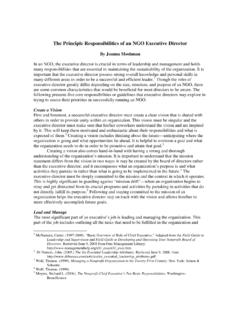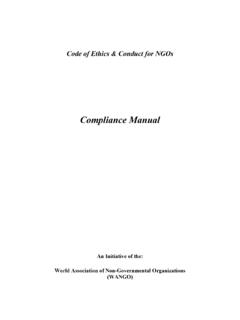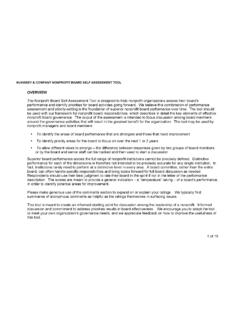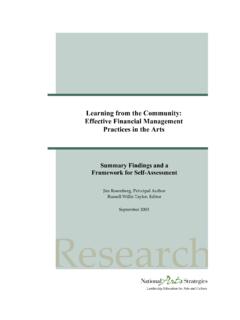Transcription of The Principle Responsibilities of an NGO Executive …
1 The Principle Responsibilities of an NGO Executive Director By Joanna Moshman In an NGO, the Executive director is crucial in terms of leadership and management and holds many Responsibilities that are essential in maintaining the sustainability of the organization. It is important that the Executive director possess strong overall knowledge and personal skills in many different areas in order to be a successful and efficient Though the roles of Executive director greatly differ depending on the size, structure, and purpose of an NGO, there are some common characteristics that would be beneficial for most directors to be aware. The following presents five core Responsibilities or guidelines that Executive directors may explore in trying to assess their priorities in successfully running an NGO.
2 Create a Vision First and foremost, a successful Executive director must create a clear vision that is shared with others in order to provide unity within an organization. This vision must be singular and the Executive director must make sure that his/her coworkers understand the vision and are inspired by it. This will keep them motivated and enthusiastic about their Responsibilities and what is expected of Creating a vision includes thinking about the future anticipating where the organization is going and what opportunities lie ahead. It is helpful to envision a goal and what the organization needs to do in order to be proactive and attain that Creating a vision also comes hand-in-hand with having a strong and thorough understanding of the organization s mission.
3 It is important to understand that the mission statement differs from the vision in two ways: it may be created by the board of directors rather than the Executive director, and it encompasses what an organization s purpose is and what activities they partake in rather than what is going to be implemented in the The Executive director must be deeply committed to the mission and the context in which it operates. This is highly significant in guarding against mission drift when an organization begins to stray and get distracted from its crucial programs and activities by partaking in activities that do not directly fulfill its Following and staying committed to the mission of an organization helps the Executive director stay on track with the vision and allows him/her to more effectively accomplish future goals.
4 Lead and Manage The most significant part of an Executive s job is leading and managing the organization. This part of the job includes outlining all the tasks that need to be fulfilled in the organization and 1 McNamara, Carter. (1997-2008). Basic Overview of Role of Chief Executive . Adapted from the Field Guide to Leadership and Supervision and Field Guide to Developing and Operating Your Nonprofit Board of Directors. Retrieved June 9, 2008 from Free Management Library: 2 Di Frances, John. (2005.) The Six Essential Leadership Attributes. Retrieved June 9, 2008, from 3 Wolf, Thomas. (1999). Managing a Nonprofit Organization in the Twenty-First Century. New York: Simon & Schuster. 4 Wolf, Thomas.
5 (1999). 5 Moyers, Richard L. (2006). The Nonprofit Chief Executive s Ten Basic Responsibilities . Washington: BroadSource. referring back to the vision in order to help complete the It is important for the Executive director to think about: What tasks are being fulfilled now? What tasks are not being fulfilled that need to be? What new activities and tasks need to be redefined and changed?7 The role of Executive director also entails hiring and managing the rest of the staff. (This excludes the board of directors who are above the Executive director and are responsible for hiring him/her. The primary difference between the two jobs is that the board of directors governs and deals with problems that the director brings to their attention, while the Executive director focuses on managing the organization and staff.)
6 8 In doing so, the director should make sure that programs are being efficiently run and that the staff is fulfilling their Responsibilities , whether in teams or individually. One way to ensure this is to prepare an organizational chart that institutes lines of authority. This provides the Executive director with an understanding of to whom his/her employees should report when they have fulfilled a task, or to whom they should talk to when they are having problems with a person or responsibility. The following is an example of such a chart:9 This chart helps organize an Executive officer s Responsibilities in that he knows with whom he directly deals. For example, the Executive director would not deal directly with the financial officer because this would undermine the authority of the 6 Moyers, Richard L.
7 (2006). 7 Wolf, Thomas. (1999). 8 Minnesota Council of Nonprofits. Governance: Basics. Retrieved June 10, 2008, from 9 Wolf, Thomas. (1999). Board of Directors Executive Director Administrative Advisor Program/Activity Advisor financial Officer financial Assistant Coordinator #1 Communications Officer Communications Assistant Clerk #1 Clerk #2 Coordinator #2 Assistant to Coordinator #1 Assistant to Coordinator #2 administrative advisor; he/she is responsible in speaking to the administrative advisor, who would then deal with the financial Lastly, the Executive director s management of the staff also includes: Motivating employees by being inspiring and remaining optimistic even when challenges are being faced. Encouraging good performance and values.
8 Allocating resources and supplies to the staff in order to make sure they have the correct equipment to complete their Responsibilities to the highest potential. Making sure that programs and activities are being laid out efficiently and as effectively as possible. Ensure that the activities implemented are of good quality and relevant to the mission and vision of the organization. Advocating and embracing Being a leader by setting high standards and living by these standards, mentoring and instilling hope in coworkers and followers, and making hard decisions and critical Engage the Community Engaging the external community is a core responsibility for an Executive director because it is crucial in building essential relationships for the NGO.
9 The director should be invested in building relationships with both the outside community and with the population that the NGO is targeting. Promoting awareness of the organization to the outside community is essential in recruiting donors and volunteers in order to help assist the organization. Furthermore, the population that the NGO intends to aid must feel genuinely supported and connected with the people, vision, and mission of the The Executive director is responsible for promoting this connection and is, therefore, the public face of the organization. The director must advocate him/herself as a spokesperson that both listens and communicates through physical and verbal language. He/she must also implement relevant activities and programs that benefit the target Responsible and effective ways to do this include: Listening to the community s needs.
10 Recognizing and supporting change within the community. Utilizing essential interpersonal, communication, and listening Supplying the community with necessary financial , human, and technological resources. Using the information gained through community programs to promote greater public awareness of relevant Assessing whether programs and activities have been successful by talking to community members and getting their feedback. 10 Wolf, Thomas. (1999). 11 Moyers, Richard L. (2006). 12 Di Frances, John. (2005). 13 Wolf, Thomas. (1999). 14 Wolf, Thomas. (1999). 15 Wolf, Thomas. (1999). 16 Moyers, Richard L. (2006). Manage financial /Fundraising Affairs While there will most likely be a comptroller or financial bookkeeper in an NGO, the Executive director is still responsible for making daily and monthly financial decisions.











